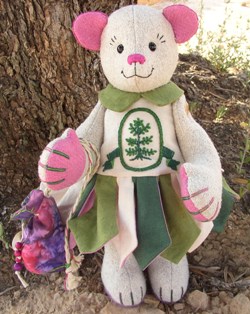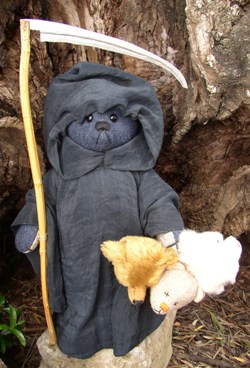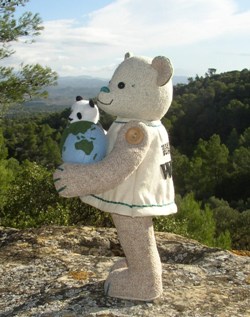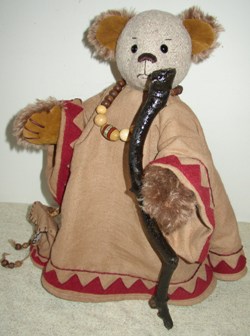The History of Ecobears
The Source caught up with Ecobear creator, Yvonne Wright, to find out more about her fabulous creation.
Read our interview to find out just where the Ecobears come from and how they are created.
Why do Ecobears make teddy bears as opposed to other animals?
That's pretty easy, really - because teddy bears are definitely the most fun! It's so lovely seeing the character of the bear evolve as I make it. To be fair Ecobears has really always been about teddies, and started out making One of a Kind collectors' bears, showing at lots of fayres around the UK a few years back.
It's only in more recent years people have asked: can you make an elephant/hippo etc. As a kid I made very basic soft-toys such as hedgehogs, giraffes, mice, monkies and a cow!
So I'm now drawing on that experience to make new, improved designs of animals. A couple of characters from the book - 'Faz' & 'Taggs' - are actually 'Ecoyetibears' (a rare breed of Ecobear). Both bears come from a small tribe found in the mountain ranges of Vynen, known as Try-Bryds. so these are completely made up animals.
Also, starting in 1993 I designed and made quite a few things using hemp fabrics - accessories, clothes and soft-furnishings. It was a great experience to learn just how many things could be made from these unique fabrics.
But by February, 1996, I decided it would be much easier to concentrate on just one idea. It was around this time David, my partner, started writing ideas for children's stories. Creating character bears seemed the best idea - and so Ecobears began life. It seemed I shared a passion for bearmaking around that time with many talented people, who were creating great artistic work.
We humans have had a long, undisputed love affair with the teddy bear, who has his own history dating back to 1902 when Margaret Steiff, a German toymaker, with the help of her nephew, Richard Steiff, were responsible for creating the very first soft-toy bear. Most people you meet, young or old, always have a story to share about their most favourite childhood teddy bear friend.
What about the materials you use?
Well, the materials I use are probably the most important part of making an Ecobear. The majority are made using vintage English hemp/recycled cotton/recycled wool mix fabric. This particular fabric dates back to 1993, and was produced in the UK. I began using it to make Ecobears in 1996, and at the time it was very unusual - I'm still using this fabric for present day bears.
Though we're living on a finca in Catalunya, most of the materials I use for the bears are UK sourced. (Ecobears originally began in the UK, when David & I lived there). I use two different kinds of stuffings; they're both 100% recycled. I use Italian olive wood button for the limb joinings.
Also Irish flax, mohair, cashmere and all kinds of new recycled fabrics, as well as bits and pieces or 'reclaimed' fabric that I think will look good. For other bear accessories and clothes I may use pieces of 100% hemp; hemp/organic cotton; hemp/silk; silk etc.
Each Ecobear made with leave the finca with his or her very own signed adoption details, printed on hemp card. It has personal details such as: name; date of birth; materials used to make the bear, etc.
Where do Ecobears come from?
Ecobears began life many years ago, as a combination of two passions: soft toy making and environmental interest.
I'm so proud to be able to continue this twin passion. The bears themselves are all individually handmade by me, and take a great deal of time to create. As mentioned, they are designed and sewn on our finca, using photovoltaic solar energy to power the sewing machines in the workshop. As we live off-grid, it is essential to have solar energy here. So hopefully Ecobears are little advocates for the use of this kind of alternative energy.
One of the nicest things I find is if someone gets in touch with you, and says they would like a particular kind of bear making; one that will be very personal to the recipient, maybe even having their name embroidered on and the bear being named after them - or a particular colour/theme etc. - how happy they are to receive their bear.
Especially if it's a complete surprise!
It's great seeing photos of bears in their new homes. The bears are a highly personalised gift; to be cherished for years to come.
What's very fulfilling is having a radical idea for a design on paper, then eventually (after however many hours later, and a few faux pas!), it actually comes to life as a 3D piece of art.
Sometimes you don't know if an idea will work until you actually try it. And so much is learned from mistakes made along the way.
My dream is that Ecobears will bring environmental awareness to a larger audience.
At the core of the Ecobear idea is a unique and much ignored fibre: hemp.
Put simply, it's a plant which many believe can provide answers to some of the ecological problems the world faces today.
I chose to make the bears from hemp because of its versatility and strength. Nowadays it's making a very positive impact on society. It can be used to make more than 25,000 products including cosmetics, paper, textiles, building materials, biomass, plastics & foods.
Bears in general give warmth, love & friendliness without asking for anything in return.
That makes them ideal to carry the message that there is an alternative to the wastefulness and damage going on in our disposable society. Bears are here for the good times in life and the bad.
Ecobears are here to help educate, provide fun, personality and entertainment. They also show what lovely things can be made from environmentally friendly materials.
What's so fab now is the release of 'The Ecobears' illustrated childrens book - published in the UK by My Little Big Town.
It's an exciting and action packed children's book with a message of caring for the environment and the protection of the Earth's resources.
Find out more at www.ecobears.com